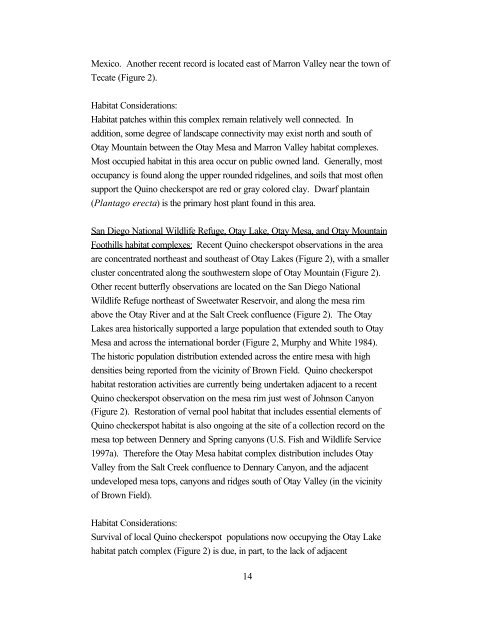Outline of Quino Recovery Plan - The Xerces Society
Outline of Quino Recovery Plan - The Xerces Society
Outline of Quino Recovery Plan - The Xerces Society
Create successful ePaper yourself
Turn your PDF publications into a flip-book with our unique Google optimized e-Paper software.
Mexico. Another recent record is located east <strong>of</strong> Marron Valley near the town <strong>of</strong><br />
Tecate (Figure 2).<br />
Habitat Considerations:<br />
Habitat patches within this complex remain relatively well connected. In<br />
addition, some degree <strong>of</strong> landscape connectivity may exist north and south <strong>of</strong><br />
Otay Mountain between the Otay Mesa and Marron Valley habitat complexes.<br />
Most occupied habitat in this area occur on public owned land. Generally, most<br />
occupancy is found along the upper rounded ridgelines, and soils that most <strong>of</strong>ten<br />
support the <strong>Quino</strong> checkerspot are red or gray colored clay. Dwarf plantain<br />
(<strong>Plan</strong>tago erecta) is the primary host plant found in this area.<br />
San Diego National Wildlife Refuge, Otay Lake, Otay Mesa, and Otay Mountain<br />
Foothills habitat complexes: Recent <strong>Quino</strong> checkerspot observations in the area<br />
are concentrated northeast and southeast <strong>of</strong> Otay Lakes (Figure 2), with a smaller<br />
cluster concentrated along the southwestern slope <strong>of</strong> Otay Mountain (Figure 2).<br />
Other recent butterfly observations are located on the San Diego National<br />
Wildlife Refuge northeast <strong>of</strong> Sweetwater Reservoir, and along the mesa rim<br />
above the Otay River and at the Salt Creek confluence (Figure 2). <strong>The</strong> Otay<br />
Lakes area historically supported a large population that extended south to Otay<br />
Mesa and across the international border (Figure 2, Murphy and White 1984).<br />
<strong>The</strong> historic population distribution extended across the entire mesa with high<br />
densities being reported from the vicinity <strong>of</strong> Brown Field. <strong>Quino</strong> checkerspot<br />
habitat restoration activities are currently being undertaken adjacent to a recent<br />
<strong>Quino</strong> checkerspot observation on the mesa rim just west <strong>of</strong> Johnson Canyon<br />
(Figure 2). Restoration <strong>of</strong> vernal pool habitat that includes essential elements <strong>of</strong><br />
<strong>Quino</strong> checkerspot habitat is also ongoing at the site <strong>of</strong> a collection record on the<br />
mesa top between Dennery and Spring canyons (U.S. Fish and Wildlife Service<br />
1997a). <strong>The</strong>refore the Otay Mesa habitat complex distribution includes Otay<br />
Valley from the Salt Creek confluence to Dennary Canyon, and the adjacent<br />
undeveloped mesa tops, canyons and ridges south <strong>of</strong> Otay Valley (in the vicinity<br />
<strong>of</strong> Brown Field).<br />
Habitat Considerations:<br />
Survival <strong>of</strong> local <strong>Quino</strong> checkerspot populations now occupying the Otay Lake<br />
habitat patch complex (Figure 2) is due, in part, to the lack <strong>of</strong> adjacent<br />
14
















